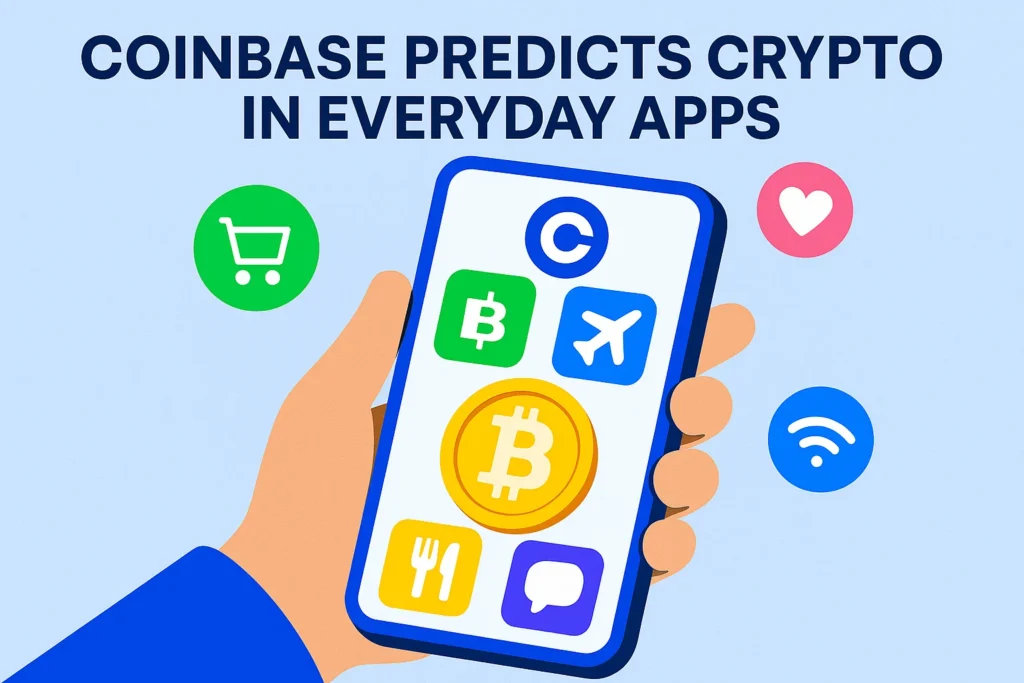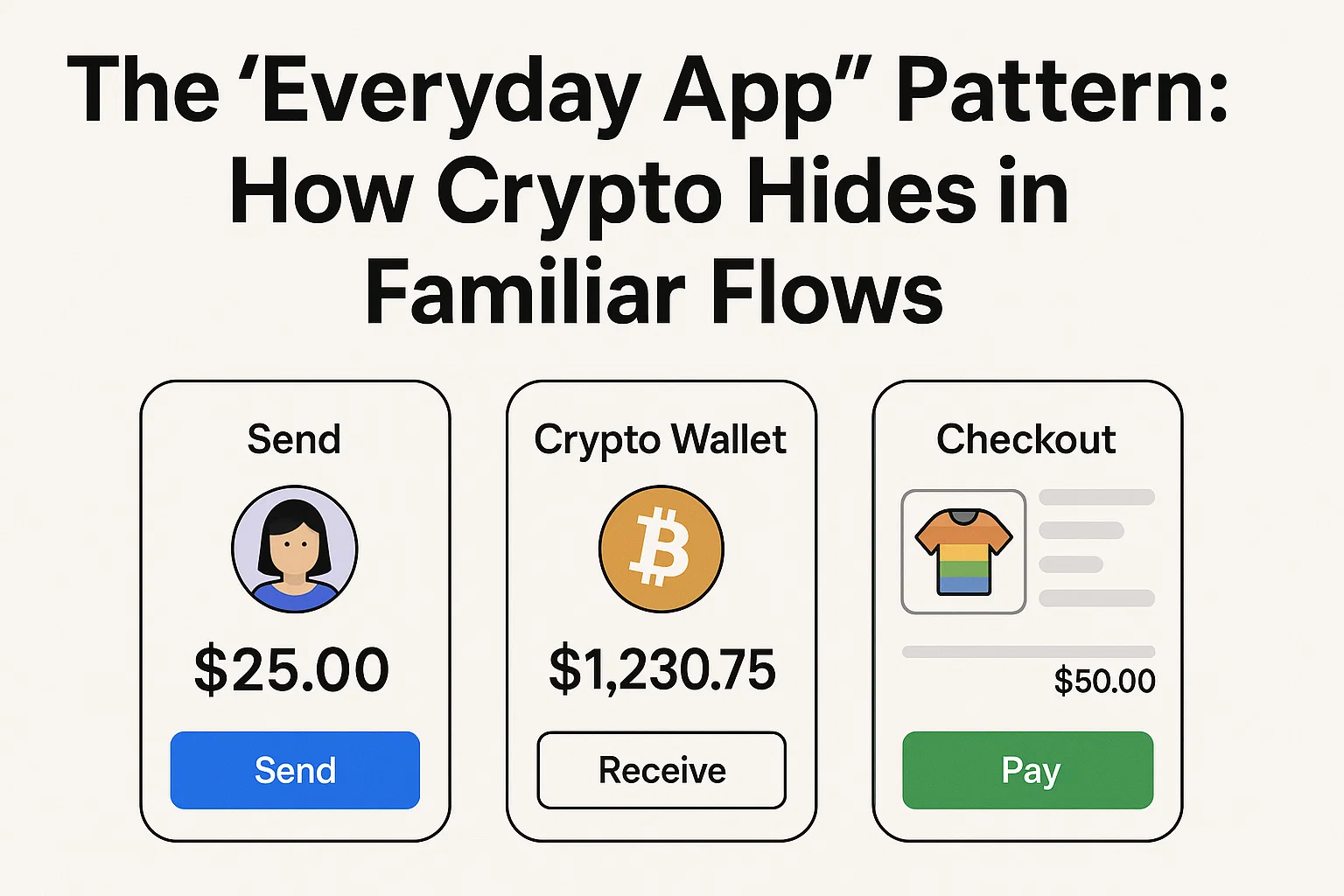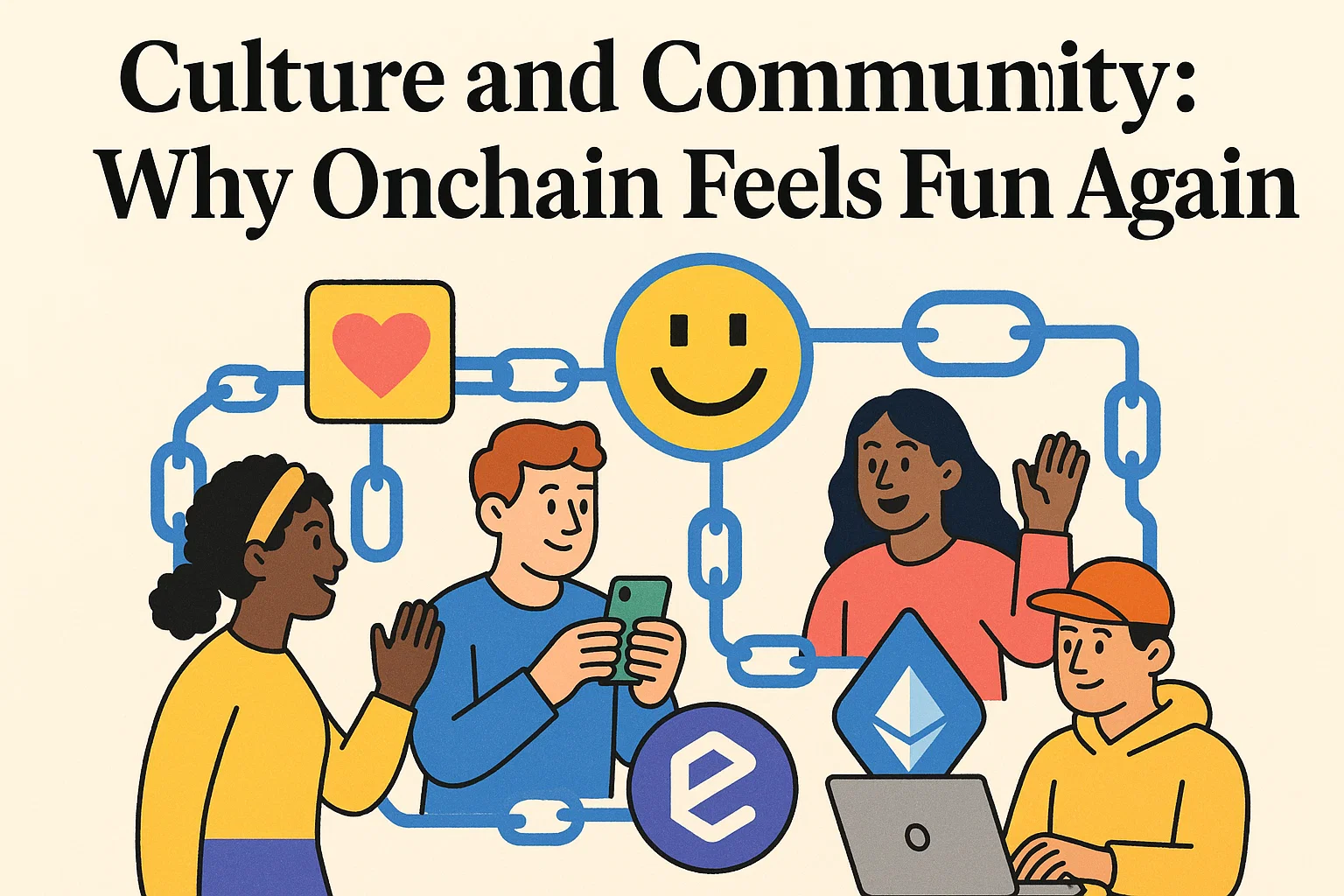Crypto rails will fade into the background—embedded inside the apps you already use to shop, stream, chat, and pay. That’s the essence of Coinbase’s prediction: a silent on-chain shift where blockchain becomes an invisible layer powering faster, cheaper, and programmable experiences while the familiar front-ends stay, well, familiar. Coinbase leadership has been explicit about this trajectory—calling it the moment when “on-chain is the new online,” and projecting that a meaningful slice of global value will operate on these rails within this decade.
Coinbase Predicts Crypto: This “hidden in plain sight” thesis reframes mainstream adoption. Instead of expecting everyone to learn seed phrases and gas fees, Coinbase Predicts Crypto: the industry is now focused on smart wallets, passkeys, account abstraction, sponsored gas, and stablecoin payments that remove friction. Coinbase’s Base ecosystem and its seasonal Onchain Summer showcases demonstrate how on-chain creativity—music, art, gaming, loyalty, and payments—can reach everyday users without the jargon.
Below, we’ll explore why this shift is happening, the product and policy catalysts that make it feasible, and what it means for builders, brands, and consumers. We’ll unpack the architecture—Layer 2 networks, stablecoins, tokenized assets, on-chain finance—and dig into user experience patterns that let crypto disappear while value creation accelerates.
Why Coinbase Believes the Next Adoption Curve Is Invisible
The old model of onboarding was gated by complexity: separate apps for exchange and self-custody, mental models for gas, and a high-stakes recovery experience. Coinbase’s recent public commentary, events, and research position the future very differently. The company emphasizes payments-first product momentum, bipartisan policy progress, and on-chain experiences that expand beyond pure finance into culture and commerce. Put differently, crypto is moving “from fringe to foundational.
At the same time, broader ecosystem signals validate the thesis. Major payments firms now explicitly discuss “onchain finance,” rebranding DeFi’s capabilities for a mainstream audience and building the rails that banks and fintechs can use. This isn’t about speculation; it’s about modernizing settlement, credit, and data-sharing with programmable money.
Coinbase’s leadership has been equally clear about the scale of the opportunity, arguing that by 2030 a significant share of global GDP could live on crypto rails. While forecasts vary, what matters most is the direction of travel: a utility-first, app-embedded future where consumers reap benefits—speed, global reach, loyalty, new media formats—without switching apps or learning new workflows.
The Building Blocks: From Onramps to Onchain UX: Coinbase Predicts Crypto
Smart Wallets and Account Abstraction
User experience is the keystone. Smart wallets let apps handle permissions, recovery, and fee abstraction so users can sign in with a passkey, tap once, and finish a transaction—no seed phrase needed. Sponsored, “gasless” transactions remove a major cognitive barrier: the need to hold a separate token just to pay for network fees. Coinbase products and partnerships have championed these patterns, reducing the time from curiosity to first on-chain action.
Layer 2s and the Cost Curve
Scaling is a prerequisite for invisibility. Layer 2 networks like Base push transaction costs and confirmation times down, enabling use cases—micro-payments, on-chain loyalty, creator economies—that simply don’t work at $10 per transaction. Coinbase’s Onchain Summer campaigns on Base demonstrated how cheaper, faster rails unlock experimentation across art, music, gaming, and food. It’s less about one viral mint and more about hundreds of small, habitual interactions that compound into daily use.
Stablecoins, Tokenized Assets, and Everyday Money
If crypto is to be invisible, users must think in stable value. That’s where stablecoins and tokenized deposits come in, acting as the settlement medium for day-to-day flows while the chain manages finality and programmability. Institutional research and third-party surveys show rising adoption intent among businesses and investors, particularly as clarity grows and integrations get simpler.
The “Everyday App” Pattern: How Crypto Hides in Familiar Flows
Embedded Wallets in Commerce and Social
Imagine opening your favorite shopping or social app. You never see a public address, never buy ETH for gas, and never copy a hash. Yet you still mint a digital collectible, tip a creator, unlock a loyalty perk, or redeem a token-gated discount with a single tap. That’s the embedded wallet pattern: the app holds a smart account for you (custodial or user-controlled), permissions are scoped to that specific brand, and the wallet only surfaces when needed.
As major tech and financial brands continue to connect payments to on-chain experiences—think wallet linking inside mainstream payments apps and banking portals—the “crypto” part fades from view while the benefits remain. Industry reporting has highlighted these integrations as a key route to mainstream retail access, with consumer payment platforms bridging users straight into on-chain activity.
Loyalty and Rewards That Travel
On-chain loyalty turns points into programmable assets. A coffee chain can issue tokens that work across partners, redeem on-site or online, and unlock interoperable rewards. Creators can airdrop experiences to superfans and carry perks across platforms. Because the assets are on-chain, they’re portable, measurable, and composable—a brand graph that the user actually owns.
Streaming, Gaming, and Creator Monetization
For streaming and gaming, on-chain primitives enable pay-per-view, in-game marketplaces, and secondary sales that pay royalties automatically. Smart-contract-based splits let collaborators monetize transparently. The Base ecosystem’s seasonal activations have already showcased many of these use cases, with daily features keeping the spotlight on creators and developers experimenting in public.
Policy, Trust, and the Institutional Arch
No invisible infrastructure gets adopted without trust. Coinbase’s framing emphasizes policy momentum in the U.S. and abroad, plus institutional-grade infrastructure that traditional finance can plug into. As banks, payment networks, and card schemes articulate their on-chain strategies—particularly around lending, credit, and data transport—the perceived risk of integration drops. That’s how crypto moves from niche tech to regulated rails powering standard financial products behind the scenes.
At the same time, investor and enterprise sentiment is measurably improving. Surveys from large consultancies find growing enthusiasm and intent to adopt digital assets as regulation clarifies and the UX improves. This converges neatly with Coinbase’s product roadmap: reduce friction for consumers, provide compliance and risk tooling for enterprises, and let builders focus on use cases rather than plumbing. (EY)
Coinbase’s Flywheel: Base, Builders, and Business
Base as the Developer Substrate
Base is a developer-friendly Layer 2 that combines low fees with easy distribution via Coinbase’s reach. The chain has leaned into culture—hackathons, showcases, and grants—to attract builders who care about everyday experiences. The Onchain Summer events and daily creator spotlights aren’t just marketing; they’re curation mechanisms that help non-crypto users discover compelling apps from trusted signals.
From Retail to Enterprise: The Coinbase Business Push
On the enterprise side, Coinbase has been preparing tools that help companies embed stablecoin payments, custodial flows, and crypto-native finance inside their existing software stacks. Recent reporting describes a Coinbase Business initiative aimed at making this integration simpler, accelerating what they term “invisible adoption.” For CFOs and product managers, the pitch is straightforward: reduce settlement cost and time, reach global users, and unlock new revenue with on-chain finance without forcing customers to learn new behaviors.
Research and Guidance for Institutions
Coinbase’s institutional research outlines themes for market structure, user experience, and macro drivers—emphasizing that better UX and compliance-ready primitives are catalyzing real-world adoption in 2025 and beyond. For treasury teams evaluating stablecoin settlements or funds exploring tokenized markets, such guidance lowers the organizational barrier to experimenting with on-chain rails.
The Technology Making Crypto Disappear
Abstracting Keys Without Sacrificing Control
Passkeys and social recovery shift the mental model from “memorize a secret forever” to “recover like any modern account.” This allows mainstream users to experience self-custody with safety nets or choose trusted custodians without losing portability. The net effect: a login flow that feels like the rest of the internet while preserving on-chain benefits—ownership, composability, and permissionless innovation.
Gasless and Sponsored Transactions
For an invisible experience, payments must “just work.” Sponsored gas lets apps or membership programs cover network fees or batch them in the background. Coinbase’s membership and wallet programs have promoted this pattern to compress the time from “download” to “done” into a single action. That’s how on-chain actions become as casual as a “like” or a tap-to-pay gesture.
Interoperability, Not Walled Gardens
Because on-chain assets are open and portable, brands can build interoperable loyalty, creators can distribute across platforms, and finance can settle across networks. The “invisible” piece isn’t secrecy—it’s standardization: the more common the primitives (ERC-20, ERC-721, ERC-1155, account-abstraction standards), the less every app has to reinvent core functions. Consumers get a consistent experience; developers ship faster.
The Business Case: Margins, Retention, and New Revenue
Lower Costs and Faster Settlement
On-chain rails eliminate layers of intermediary fees and reduce chargeback risk with programmable settlement. For cross-border commerce and marketplace payouts, stablecoins settle globally in minutes, often at a fraction of traditional costs. In an “invisible crypto” model, the user simply checks out; behind the scenes, USDC or tokenized deposits provide finality and auditability.
Retention Through Digital Ownership
On-chain ownership is a retention engine. When users hold brand assets they can actually use, trade, or carry between communities, they’re more likely to return and engage. Token-gated experiences become more than coupons—they’re passports to a network of benefits. Musicians can grant backstage access to holders, games can grant cross-title perks, and retailers can coordinate campaigns with partners without building bespoke integrations.
New Revenue via Programmable Commerce
Smart contracts enable micropayments, usage-based pricing, and royalty splits at internet scale. This opens revenue streams that traditional rails can’t support efficiently. Apps can share fees with creators in real time; marketplaces can route payouts to multiple parties without reconciliation headaches. The best part: users don’t need to know any of this. They just see clear pricing and faster value.
Risk, Compliance, and How “Invisible” Stays Responsible
KYC Where It Matters, Privacy Where It Counts
Invisible crypto doesn’t mean invisible compliance. Well-designed flows move identity checks to the edges—onramps and offramps, specific regulated actions—while preserving the benefits of on-chain transparency and selective disclosure. Zero-knowledge proofs and on-chain attestations will increasingly allow apps to verify facts (“over 18,” “resident of X,” “passed KYC”) without exposing more than necessary.
Token Listings, Liquidity, and the Long Tail
The broader ecosystem continues to evolve around transparent listing processes and issuer-facing programs that aim to standardize how assets reach markets. For builders, easier paths to liquidity can accelerate product feedback cycles. For users, it means more consistent quality and a better chance that the assets powering their favorite app meet baseline transparency.
Institutional Rails and Risk Tooling
As payment networks and institutions lean into on-chain finance, they’re building the data, custody, and risk layers that enterprises expect. This is crucial for the “everyday app” thesis: when enterprise-grade rails are available, product teams can integrate crypto features without reinventing compliance or taking balance-sheet risks they don’t understand.
Culture and Community: Why Onchain Feels Fun Again
From Hype Cycles to Habits
The most durable indicator of adoption is habit formation. On-chain experiences are sticking because they’re practical (cheap, fast, global) and playful (collectibles, fandom, remix culture). Coinbase’s Onchain Summer and Onchain Daily spotlights favor many small, repeatable interactions over headline-grabbing mints. This lowers the stakes and invites participation from people who would never call themselves “crypto users,” but will gladly tap-to-collect or tap-to-pay inside apps they trust.
The Creator Renaissance
Creators finally have native internet money with programmable distribution. Whether it’s instant payouts, shared royalties, or token-gated communities, the on-chain stack brings financial gravity to digital culture. When this is embedded into the platforms creators already use—social feeds, storefronts, live-streaming—crypto becomes an engine, not an obstacle.
What Comes Next: A Roadmap to the Silent Onchain Shift
Short Term (Next 12–18 Months)
Expect more wallet-in-app launches, merchant pilots with stablecoin settlement, and creator programs that reward engagement with on-chain perks—all wrapped in everyday interfaces. Enterprise rollouts like Coinbase Business are designed to make the leap from pilot to production, especially for mid-market companies that need batteries-included compliance and payout tooling.
Medium Term (2–3 Years)
Tokenization of real-world assets, programmable loyalty networks, and interoperable identity will mature. More banks and networks will articulate their on-chain strategies, expanding lending, credit, and data-sharing rails that traditional developers can consume like APIs. With each new primitive, the line between “web2” and “onchain” blurs further.
Long Term (By 2030)
If Coinbase’s thesis holds, a meaningful share of global value will settle onchain—largely invisible to end users but material for margins, speed, and innovation. The on-chain internet becomes the default settlement layer; apps compete on design, community, and utility rather than payments plumbing.
Conclusion
The mainstreaming of crypto won’t be loud. It will be a quiet upgrade to the internet’s money layer—where every checkout, subscription, tip, ticket, stream, and loyalty action can be faster, programmable, and global by default. Coinbase’s silent on-chain shift thesis captures this perfectly: crypto succeeds when it seamlessly powers the apps people already love, not when it demands a new mental model.
For builders, that means prioritizing UX, compliance, and distribution—leaning on platforms and policies that make it safe and simple. For brands, it means designing interoperable loyalty and creator programs that travel with customers. And for users, it means enjoying better products without having to become a blockchain expert. If “onchain is the new online,” the future of the internet will be one tap away—and most people won’t even know the rails changed.
FAQs
Q: What does “invisible” or “silent” on-chain adoption actually mean?
It means crypto functionality is embedded inside familiar apps, so users don’t need to learn wallets, chains, or gas. They sign in with passkeys, tap to buy or collect, and the app handles the on-chain steps behind the scenes using smart wallets, sponsored gas, and stablecoins. Coinbase Predicts Crypto: Coinbase and partners have been building toward this model with Base and membership programs that abstract fees and complexity.
Q: Why is Coinbase so confident this will work?
Coinbase points to policy progress, better user experience, and a shift from speculative trading to practical use cases—payments, loyalty, media, and creator monetization. Coinbase Predicts Crypto: Company events and research frame crypto as moving Coinbase Predicts Crypto: “from fringe to foundational, with on-chain experiences Coinbase Predicts Crypto reaching beyond finance into culture and everyday commerce.
Q: Do I need to hold crypto tokens to pay for gas or use these features?
Not necessarily. Many apps will use sponsored or “gasless” transactions, and stablecoins can handle value transfer without users ever touching a volatile asset. Coinbase Predicts Crypto: Memberships and wallets can batch or cover fees, Coinbase Predicts Crypto: so checkout feels like any other app.
Q: What role does Base play in the silent on-chain shift?
Base provides low-cost, high-throughput rails for on-chain experiences and a vibrant builder community. Seasonal activations like Onchain Summer showcase cultural and commercial use cases—art, music, Coinbase Predicts Crypto: gaming, food—making it easier for non-crypto users to try on-chain actions with minimal friction.
Q: How are traditional finance and payments companies involved?
Payment networks and financial institutions are positioning Coinbase Predicts Crypto: themselves as infrastructure providers for on-chain finance, offering the rails for lending, Coinbase Predicts Crypto: custody, data, and settlement that enterprises need. Coinbase Predicts Crypto: This institutional backbone is key to bringing embedded crypto to mainstream apps used by millions.



